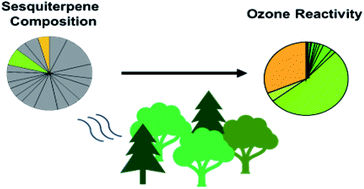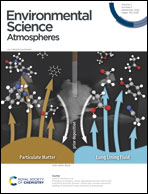Composition, concentration, and oxidant reactivity of sesquiterpenes in the southeastern U.S.†
Abstract
Biogenic volatile organic compounds (BVOCs) contribute the majority of reactive organic carbon to the atmosphere and lead to aerosol formation through reaction with atmospheric oxidants including ozone and hydroxyl radicals. One class of BVOCs, sesquiterpenes, have a high reactivity with ozone but exist at lower concentrations compared to other BVOCs, and there are relatively few measurements of their concentrations in different environments or their importance in the atmospheric oxidant budget. To help close this knowledge gap, we examine concentrations of isomer-resolved sesquiterpene concentrations collected hourly at two sites in Virginia that are representative of different ecosystems in the southeastern US. Sesquiterpene concentrations are presented and discussed in relation to their diurnal patterns and used to estimate their contribution to reactivity with common gas-phase oxidants. Twenty-four sesquiterpenes were identified at the sites, eleven of which were observed at both sites. Total sesquiterpene concentrations were found to range between 0.8 and 2 ppt with no single isomer dominating throughout. Hydroxyl activity is similarly diverse, with no particular isomer dominating activity at either site. Ozone reactivity, however, was found to be dominated (∼3/4 total reactivity) by β-caryophyllene and humulene despite these compounds representing roughly only 10% of total sesquiterpene mass, highlighting their importance as the major driver of sesquiterpene-ozone reactivity. Average reaction rate constants for sesquiterpenes with ozone and hydroxyl radicals were calculated for both sites as a method to simplify future atmospheric modelling concerning sesquiterpenes. This work provides broad insight into the composition and impacts of sesquiterpenes, suggesting that sesquiterpene composition is relatively similar between sites. Furthermore, while the calculated average sesquiterpene-ozone reaction rate constants are at least an order of magnitude higher than that of more prevalent BVOC classes (isoprene and monoterpenes), their low concentrations suggest their impacts on atmospheric reactivity are expected to be limited to periods of high emissions.

- This article is part of the themed collection: Atmosphere – Biosphere Interactions – Topic Highlight


 Please wait while we load your content...
Please wait while we load your content...